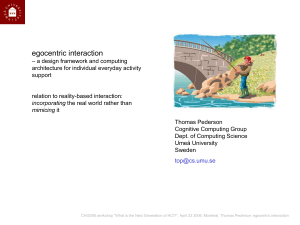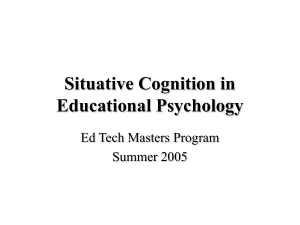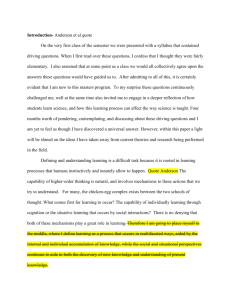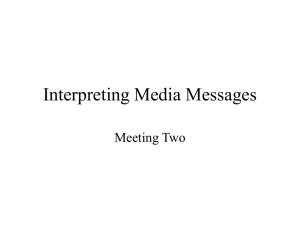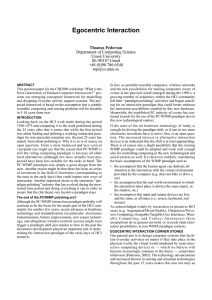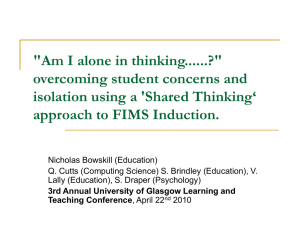A Situative Space Model for Classifying Spatially Nearby Objects
advertisement
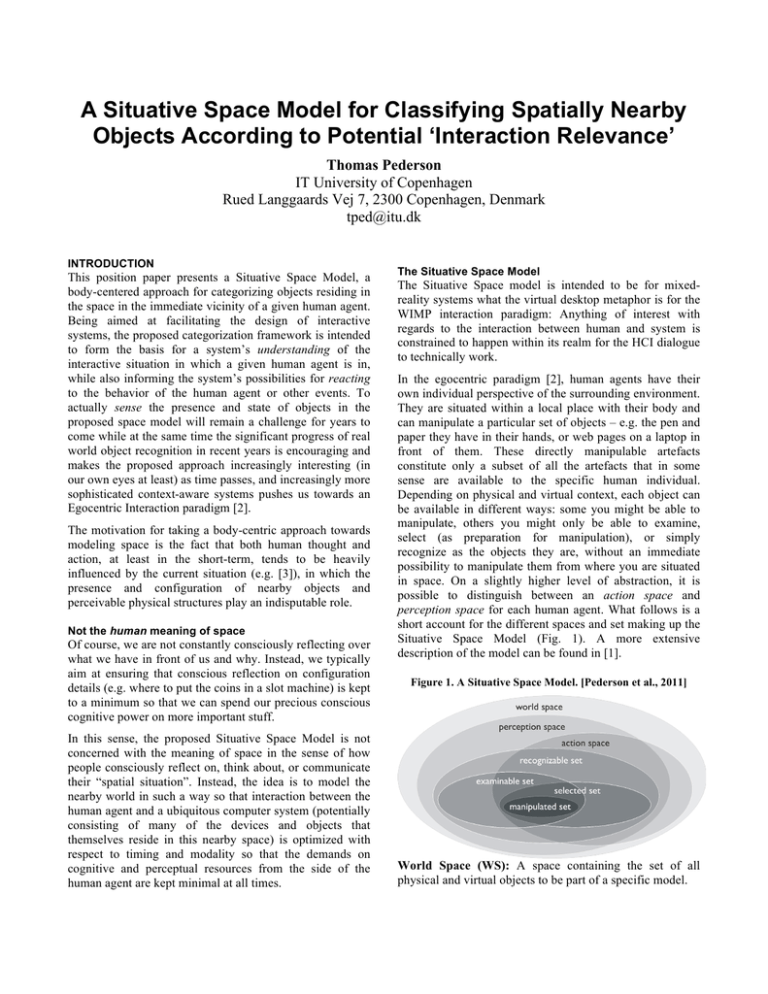
A Situative Space Model for Classifying Spatially Nearby Objects According to Potential ‘Interaction Relevance’ Thomas Pederson IT University of Copenhagen Rued Langgaards Vej 7, 2300 Copenhagen, Denmark tped@itu.dk INTRODUCTION This position paper presents a Situative Space Model, a body-centered approach for categorizing objects residing in the space in the immediate vicinity of a given human agent. Being aimed at facilitating the design of interactive systems, the proposed categorization framework is intended to form the basis for a system’s understanding of the interactive situation in which a given human agent is in, while also informing the system’s possibilities for reacting to the behavior of the human agent or other events. To actually sense the presence and state of objects in the proposed space model will remain a challenge for years to come while at the same time the significant progress of real world object recognition in recent years is encouraging and makes the proposed approach increasingly interesting (in our own eyes at least) as time passes, and increasingly more sophisticated context-aware systems pushes us towards an Egocentric Interaction paradigm [2]. The motivation for taking a body-centric approach towards modeling space is the fact that both human thought and action, at least in the short-term, tends to be heavily influenced by the current situation (e.g. [3]), in which the presence and configuration of nearby objects and perceivable physical structures play an indisputable role. Not the human meaning of space Of course, we are not constantly consciously reflecting over what we have in front of us and why. Instead, we typically aim at ensuring that conscious reflection on configuration details (e.g. where to put the coins in a slot machine) is kept to a minimum so that we can spend our precious conscious cognitive power on more important stuff. In this sense, the proposed Situative Space Model is not concerned with the meaning of space in the sense of how people consciously reflect on, think about, or communicate their “spatial situation”. Instead, the idea is to model the nearby world in such a way so that interaction between the human agent and a ubiquitous computer system (potentially consisting of many of the devices and objects that themselves reside in this nearby space) is optimized with respect to timing and modality so that the demands on cognitive and perceptual resources from the side of the human agent are kept minimal at all times. The Situative Space Model The Situative Space model is intended to be for mixedreality systems what the virtual desktop metaphor is for the WIMP interaction paradigm: Anything of interest with regards to the interaction between human and system is constrained to happen within its realm for the HCI dialogue to technically work. In the egocentric paradigm [2], human agents have their own individual perspective of the surrounding environment. They are situated within a local place with their body and can manipulate a particular set of objects – e.g. the pen and paper they have in their hands, or web pages on a laptop in front of them. These directly manipulable artefacts constitute only a subset of all the artefacts that in some sense are available to the specific human individual. Depending on physical and virtual context, each object can be available in different ways: some you might be able to manipulate, others you might only be able to examine, select (as preparation for manipulation), or simply recognize as the objects they are, without an immediate possibility to manipulate them from where you are situated in space. On a slightly higher level of abstraction, it is possible to distinguish between an action space and perception space for each human agent. What follows is a short account for the different spaces and set making up the Situative Space Model (Fig. 1). A more extensive description of the model can be found in [1]. Figure 1. A Situative Space Model. [Pederson et al., 2011] World Space (WS): A space containing the set of all physical and virtual objects to be part of a specific model. Perception Space (PS): The part of the space around the agent that can be perceived at each moment. Like all the spaces and sets defined below, it is agent-centered, varying continuously with the agent‘s movements of body and body parts. Different senses have differently shaped PS, with different operating requirements, range, and spatial and directional resolution with regard to the perceived sources of the sense data. Compare vision and hearing, e.g. Manipulated Set (MdS): The set of objects whose states (external as well as internal) are currently in the process of being changed by the agent. Within PS, an object may be too far away to be possible to recognize and identify. As the agent and the object come closer to each other (either by object movement, agent movement, or both) the agent will be able to identify it as X, where X is a certain type of object, or possibly a unique individual. For each type X, the predicate “perceptible-asX” will cut out a sector of PS, the distance to the farthest part of which will be called recognition distance. USING THE MODEL Recognizable Set (RS): The set of objects currently within PS that are within their recognition distances. All these spaces and sets, with the obvious exception of the SdS and the MdS, primarily provide data on what is potentially involved in the agent’s current activities. Cf. the virtual desktop in the WIMP interaction paradigm. The Situative Space Model (SSM) has enabled us to prototype a wearable device offering everyday activity support for people suffering early dementia in a very different way compared to if we would have taken a devicecentric space modeling approach [4]. The SSM has also proven both to be useful for activity recognition [5] (the sensing aspect of this workshop CFP) and for providing data to a multimodal interaction manager in an intelligent home application [4] (the reacting aspect). The kind of object types we are particularly interested in here are object types that can be directly associated with activities of the agent – ongoing activities, and activities potentially interesting to start up – which is related to what in folk-taxonomy studies is known as the basic level. CONCLUSION To perceive the status of a designed object with regard to its relevant (perceivable) states (operations and functions as defined by the designer of the artifact) it will often have to be closer to the agent than its recognition distance: the outer limit will be called examination distance. ACKNOWLEDGMENTS In this position paper I have presented a body-centric approach towards the modeling of the space close to a specific human agent, as alternative to device or roomcentric modeling approaches. The Situative Space Model is the result of a collaboration between Lars-Erik Janlert, Dipak Surie (both at the Dept. of Computing Science, Umeå University) and the author of this position paper. Examinable Set (ES): The set of objects currently within PS that are within their examination distances. REFERENCES Action Space (AS): The part of the space around the agent that is currently accessible to the agent’s physical actions. Objects within this space can be directly acted on. The outer range limit is less dependent on object type than PS, RS and ES, and is basically determined by the physical reach of the agent, but obviously depends qualitatively also on the type of action and the physical properties of objects involved; e.g., an object may be too heavy to handle with outstretched arms. Since many actions require perception to be efficient or even effective at all, AS is qualitatively affected also by the current shape of PS. 2. Pederson, T., Janlert, L.-E. & Surie, D. (2010). Towards a model for egocentric interaction with physical and virtual objects. In Proceedings of NordiCHI 2010. ACM Press, pp. 755-758. From the point of view of what can be relatively easily automatically tracked on a finer time scale, it will be useful to introduce a couple of narrowly focused and highly dynamic sets within AS (real and mediated). Selected Set (SdS): The set of objects currently being physically or virtually handled (touched, gripped; or selected in the virtual sense) by the agent. 1. Pederson, T., Janlert, L.-E., Surie, D. (2011). A Situative Space Model for Mobile Mixed-Reality Computing. IEEE Pervasive Computing Magazine, vol. 10, no. 4 (2011), 73-83. 3. Suchman, L. (1987). Plans and situated actions. The problem of human-machine communication. Cambridge: Cambridge University Press. 4. Surie, D., Pederson, T., Janlert, L-E. (2010). The easy ADL home: A physical-virtual approach to domestic living. Journal of Ambient Intelligence and Smart Environments, IOS Press, (2010). 5. Surie, D., Pederson, T., Lagriffoul, F., Janlert, L.-E., & Sjölie, D. (2007). Activity Recognition using an Egocentric Perspective of Everyday Objects. In Proceedings of IFIP UIC 2007, Springer LNCS 4611, pp. 246-257.
